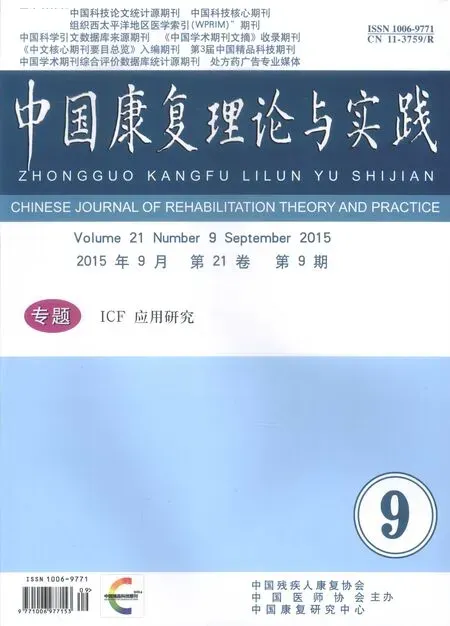音乐干预对孕期应激仔鼠恐惧行为的影响及相关机制
2015-03-04钱静宓秀菊刘树青
钱静,宓秀菊,刘树青
音乐干预对孕期应激仔鼠恐惧行为的影响及相关机制
钱静1,宓秀菊2,刘树青3
[摘要]目的研究音乐干预对孕期应激仔鼠恐惧行为和杏仁核胃泌素释放肽受体(GRPR)表达的影响。方法Wistar孕鼠16只随机分为应激组(n=8)和对照组(n=8)。应激组妊娠11~20 d每天将其置于窄小的固定器中并给予强光照射。对照组不给予刺激。应激组仔鼠出生后第1天起,予播放音乐(SM组)或相同分贝的白噪音(SW组),SC组不给予刺激。生后60 d行防御退缩试验,免疫荧光组织化学和荧光实时定量PCR测定杏仁核GRPR及其mRNA表达。结果与其他两组比较,SM组仔鼠潜伏期显著缩短(P< 0.001),出小室次数显著增多(P<0.001);杏仁核GRPR阳性细胞计数及mRNA表达显著增加(P<0.001)。结论生后给予音乐干预可以纠正孕期应激仔鼠异常的恐惧行为,同时伴有杏仁核GRPR高表达。
[关键词]孕期应激;音乐疗法;胃泌素释放肽受体;杏仁核;防御退缩试验;大鼠
[本文著录格式]钱静,宓秀菊,刘树青.音乐干预对孕期应激仔鼠恐惧行为的影响及相关机制[J].中国康复理论与实践, 2015, 21(9): 1016-1019.
CITED AS: Qian J, Mi XJ, Liu SQ. Effect and mechanism of music exposure on fearful behavior of prenatal stressed rats [J]. Zhongguo Kangfu Lilun Yu Shijian, 2015, 21(9): 1016-1019.
音乐可以改善人的焦虑、抑郁、烦躁等不良情绪,减轻疲劳及疼痛感,提高语言及认知能力。音乐疗法是应用性较强的心理疗法之一,它集音乐、医学和心理学等多种学科的理论与实践为一体,在保健和身心疾病的治疗方面具有悠久的历史[1-6]。
胃泌素释放肽(gastrin-releasing peptide, GRP)是一种应激相关肽,其受体(GRPR)在下丘脑、杏仁核、海马和新皮质等应激相关脑区广泛分布[7]。研究发现,GRP对条件恐惧表达和消失密切相关,阻断新生鼠的GRPR可导致恐惧记忆增强。束缚应激可以刺激中央杏仁核GRP和促肾上腺皮质素释放激素的释放;该部位注射GRP可以抑制大鼠的摄食行为(一种应激状态表现),提示GRP在杏仁核对恐惧的调节过程中起着重要的作用[8-12]。
孕期应激仔鼠在旷场试验、防御退缩试验及高架十字迷宫试验中均表现出过多的恐惧行为,孕期应激仔鼠已经成为研究焦虑症的成熟动物模型[13-16]。本研究对孕期应激仔鼠进行音乐干预,观察其对成年仔鼠恐惧行为及杏仁核GRPR表达的影响,以揭示音乐疗法的生理机制。
1 材料与方法
1.1动物及分组
Wistar孕鼠16只分为应激组(n=8)和对照组(n= 8)。应激组妊娠11~20 d每天置于窄小的固定器中,并予强光照射45 min,每天3次。对照组不给予刺激。仔鼠出生当天将应激组分为3组:SC组生后不给予刺激;SM组给予小提琴协奏曲《梁山伯与祝英台》(55~65 dB) 45 min,每天2次[17];SW组给予白噪音(55~65 dB) 45 min,每天2次。对照组仔鼠(CC组)不给予刺激。为了排除性别及窝别的影响,仅选择雄性仔鼠,同窝仔鼠每组不超过2只,每组均为16只。
1.2防御退缩实验
生后60 d行防御退缩实验。自制木箱60×60×35 cm,一侧连有15×20×15 cm的小室,两者之间有活动小门。60×60 cm旷场平均分为4×4个方格,光照强度75 lx;小室的光照强度<1 lx,为旷场折射的光线。
仔鼠测试前24 h在旷场适应15 min,但不允许进入小室。测试时先将其置于小室30 s,然后将小门打开。测试持续10 min,顺序随意。每次测试完毕均用稀释的84消毒液擦拭旷场和小室,消除仔鼠的气味。
2位测试人员通过监控录像对仔鼠进行评定,测定进入旷场的潜伏期、离开小室的次数、小室内的时间(不包括潜伏期)、每分钟跨越的方格线数。
1.3急性束缚应激
采用有机玻璃大鼠束缚筒,每组取8只受试仔鼠置于束缚筒内2 h,然后进行防御退缩实验测试。另8只仔鼠直接测试。
1.4组织制备
行为学测试结束后,每组取8只麻醉后灌注,取脑,固定,沉糖,包被,切片,行免疫荧光染色。另8只断头处死,开颅取出杏仁核置于-80℃保存,行荧光实时定量PCR。
1.5免疫荧光染色及细胞计数
根据大鼠大脑图谱,每组选择基底外侧核、中央核和外侧核脑片计数GRPR阳性细胞数。
1.6荧光实时定量PCR
提取经过同质加工处理后杏仁核的总RNA,逆转录成CDNA-20℃备用。应用实时定量PCR仪测定每个标本的GRPR mRNA表达。计算2−ΔΔCt,以CC组表达水平为1,其他组以与CC组的比值表示。
1.7统计学分析
应用SPSS 18.0软件进行统计学分析。所有数据用(xˉ±s)表示。行为学测试数据用2×4析因分析(广义线性模型的单变量分析);杏仁核各核团GRPR阳性细胞数用随机设计资料的方差分析。组间比较用单因素方差分析,两两比较采用LSD检验,同组束缚与未束缚行为学指标的比较采用独立样本t检验。显著性水平α=0.05。
2 结果
2.1防御退缩实验
分组和束缚对潜伏期有交互影响(F=86.68, P< 0.001)。束缚可使CC、SC、SW组潜伏期延长(P< 0.05),出小室次数减少(P<0.05),延长SC和SW组在小室内的时间(P<0.05)。但束缚应激对SM组所有指标均无影响。
方差分析显示,无论有无束缚,各组潜伏期和出小室次数均有显著性差异(P<0.05);在小室内的时间束缚后各组间有非常高度显著性差异(P<0.001)。两两比较发现,无论束缚与否,SM组均较CC组潜伏期短,出小室次数多;SC和SW组均较CC组出小室的次数减少,且束缚后潜伏期和在小室内时间较CC组延长。各组仔鼠每分钟穿越的线数无显著性差异。见表1~表4。
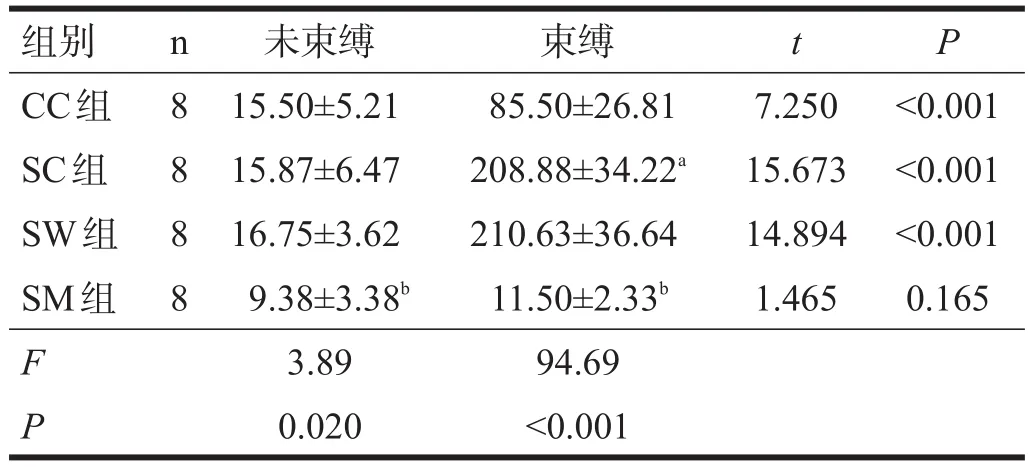
表1 各组防御退缩实验潜伏期比较(s)
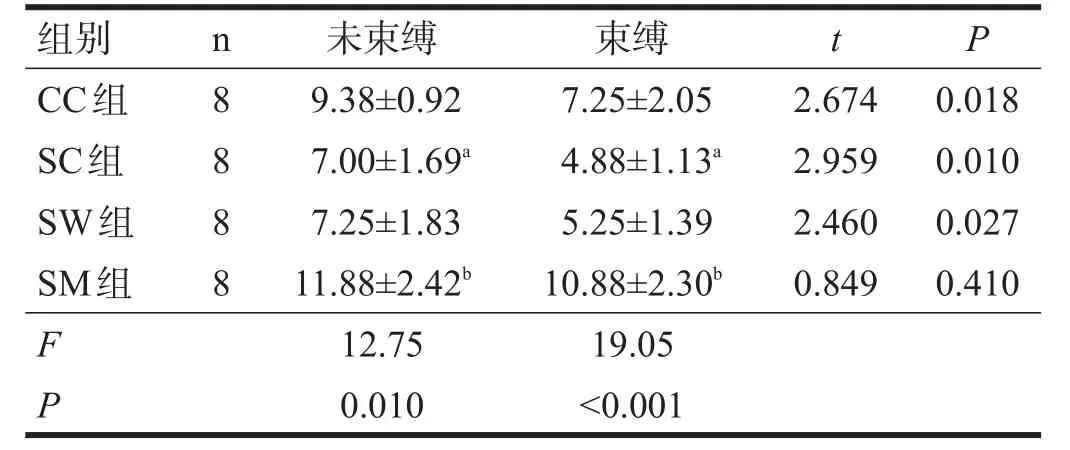
表2 各组防御退缩实验出小室次数比较(n)
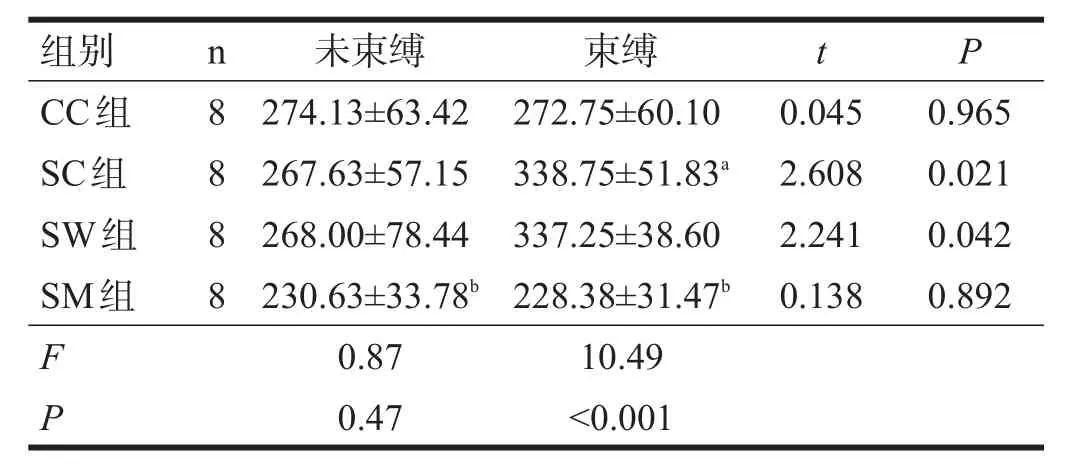
表3 各组防御退缩实验在小室内的时间比较(s)
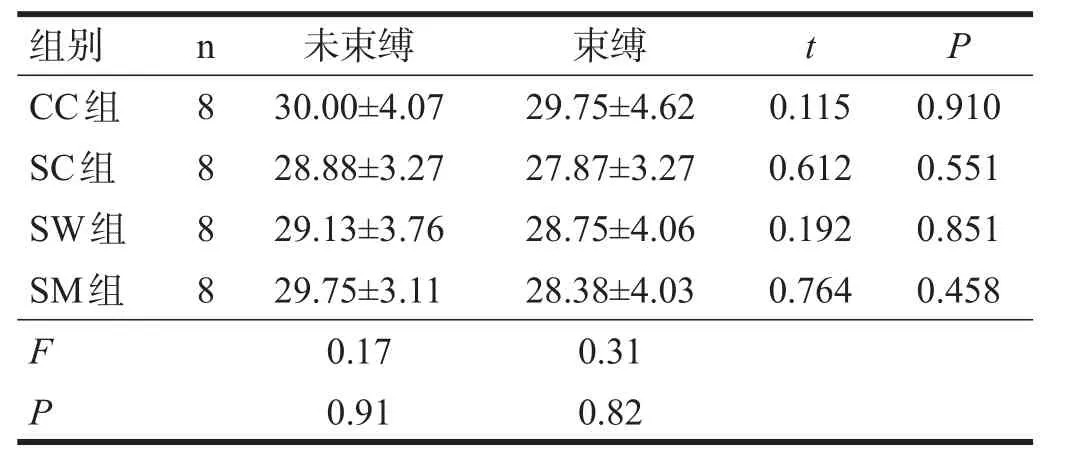
表4 各组防御退缩实验每分钟穿越的线数比较(n)
2.2杏仁核GRPR阳性细胞计数
统计学分析显示,组间(F=120.80, P<0.001)和核团间(F=258.20, P<0.001)均有非常高度显著性差异。两两比较,SM组GRPR阳性细胞数总数及各核团GRPR阳性细胞数均显著高于其他3组(P<0.001),CC、SW、SC组间无显著性差异(P>0.05)。见表5。

表5 各组不同核团GRPR阳性细胞数总数比较(n)
2.3杏仁核GRPR mRNA的表达
SM组表达水平显著升高为(98.17±24.93) (P< 0.001),SW组(1.29±0.46)、SC组(1.13±0.26)较CC组无显著性差异(P>0.05)。
3 讨论
本研究显示,孕期应激可增加成年仔鼠防御退缩试验中的恐惧行为,束缚应激可明显加剧其恐惧表现;生后给予音乐干预则可纠正其异常表现,且伴有杏仁核GRPR表达水平增高。本文首次证实了音乐对大鼠杏仁核GRPR表达的影响。
音乐是一种放松和减压的手段。Calcaterra等通过观察儿外科术后患儿发现,音乐干预可缓解术后疼痛,并降低由于疼痛及焦虑所致的心率加快、血压及血糖升高,还可提高血氧饱和度[2]。
目前已有研究证实人类音乐对动物生理及心理的影响。Bowman等发现,聆听古典音乐可以降低动物救助中心宠物狗的心率变异率、唾液皮质醇浓度,并改善其焦虑行为[18]。Howell等观察到,音乐环境下被俘小猩猩的烦躁不安及易受激惹行为明显减少[19]。王增贤等发现,在播放小提琴协奏曲《梁山伯与祝英台》时,大鼠比较安静并聚集在一起[17]。可见音乐对动物具有一定的镇静作用,可以改善动物的不良情绪和行为。我们的研究结果再次支持了这一观点。
本研究显示,接受音乐干预仔鼠杏仁核“恐惧回路”3个核团的GRPR阳性细胞数均升高。GRP是一种蛙皮素样肽,GRPR属于G蛋白偶联受体超家族,位于细胞膜上,含有7个疏水跨膜区,由384个氨基酸构成。GRP通过与GRPR结合发挥生物学效应。研究证实,GRP对情绪记忆有明显调节作用[20-21]。Shumyatsky等发现,GRPR表达于外侧杏仁核的γ-氨基丁酸能中间神经元,对下一级神经元起抑制作用[10]。GRP可兴奋这些中间神经元,从而增强其对下级神经元的抑制。GRPR基因敲除小鼠下级神经元兴奋性增高,长时程增强效应增强,从而使恐惧记忆加强。另有研究发现,GRPR在杏仁核的中央核、基底外侧核等核团也有表达,γ-氨基丁酸能神经元仅为表达GRPR细胞的一个亚群,提示GRPR参与了包括外侧杏仁核在内的多个核团对恐惧记忆的调节[22]。基于这一观点,由于所有仔鼠在行为学测试前24 h都在旷场适应15 min,半数仔鼠在试验前给予束缚应激,这些刺激都可以构成一种恐惧记忆。推测音乐组仔鼠GRPR高表达可能加强中间神经元的抑制作用,降低下级神经元的兴奋性,从而使恐惧行为减少。
胚胎期各器官,包括消化道、肺、乳腺及神经系统均有GRPR高表达,但出生后表达水平逐渐降低[23]。本研究显示,音乐干预可使孕期应激仔鼠杏仁核GRPR高表达,说明出生后给予音乐干预可以延缓杏仁核GRPR水平的下降。有研究显示,音乐干预可使下丘脑脑源性神经营养因子表达增多,神经生长因子表达减少,提示音乐的生理效应可能通过对神经营养因子的影响来调节下丘脑-垂体-肾上腺素轴的功能[24]。
目前已有研究为糖皮质激素与GRPR受体系统在分子水平的相互作用提供了依据,如地塞米松可以提高人类肺癌细胞GRPR及其mRNA的表达,GRPR拮抗剂可阻断地塞米松诱导的细胞增殖[25]。因此,音乐有可能通过对下丘脑-垂体-肾上腺素轴的调节使孕期应激仔鼠杏仁核的GRPR高表达。有待进一步研究。
[参考文献]
[1] Raglio A, Attardo L, Gontero G, et al. Effects of music and music therapy on mood in neurological patients [J]. World J Psychiatry, 2015, 5(1): 68-78.
[2] Calcaterra V, Ostuni S, Bonomelli I, et al. Music benefits on postoperative distress and pain in Pediatric day care surgery [J]. Pediatr Rep, 2014, 6(3): 5534.
[3]孙长慧,胡瑞萍,白玉龙.音乐疗法在言语康复中的应用进展[J].中国康复理论与实践, 2013, 19(7): 623-625.
[4] Phumdoung S, Good M. Music reduces sensation and distress of labor pain [J]. Pain Manag Nurs, 2003, 14(2): 54-61 .
[5] Uedo N, Ishikawa H, Morimoto K, et al. Reduction in salivary cortisol level by music therapy during colonoscopic examination [J]. Hepatogastroenterology, 2004, 51(56): 451-453.
[6] Lee D, Henderson A, Shum D. The effect of music on preprocedure anxiety in Hong Kong Chinese day patients [J]. J Clin Nurs, 2004, 13(3): 297-307.
[7] Zoeller RT, Lebacq-Verheyden AM, Battey JF. Distribution of two distinct messenger ribonucleic acids encoding gastrin-releasing peptide in rat brain [J]. Peptides, 1989, 10(2): 415-422.
[8] Martel G, Hevi C, Wong A, et al. Murine GRPR and stathmin control in opposite directions both cued fear extinction and neural activities of the amygdala and prefrontal cortex [J]. PLoS One, 2012, 7(2): e30942.
[9] Roesler R, Kent P, Schroder N, et al. Bombesin receptor regulation of emotional memory [J]. Rev Neurosci, 2012, 23(5-6): 571-586.
[10] Shumyatsky GP, Tsvetkov E, Malleret G, et al. Identification of a signaling network in lateral nucleus of amygdala important for inhibiting memory specifically related to learned fear [J]. Cell, 2002, 111(16): 905-918.
[11] Merali Z, McIntosh J, Kent P, et al. Aversive and appetitive events evoke the release of corticotropin- releasing hormone and bombesin-like peptides at the central nucleus of the amygdala [J]. J Neurosci, 1998, 18(12): 4758-4766.
[12] Fekete E, Vigh J, Bagi EE, et al. Gastrin-releasing peptide microinjected into the amygdala inhibits feeding [J]. Brain Res, 2002, 955(1-2): 55-63.
[13] Fride E, Dan Y, Feldon J, et al. Effects of prenatal stress on vulnerability to stress in prepubertal and adult rats [J]. Physiol Behav, 1986, 37(5): 681-687.
[14] Martijena ID, Calvo N, Volosin M, et al. Prior exposure to a brief restraint session facilitates the occurrence of fear in response to a conflict situation: behavioral and neurochemical correlates [J]. Brain Res, 1997, 752(1-2): 136-142.
[15] Valle´e M, Mayo W, Dellu F, et al. Prenatal stress induces high anxiety and postnatal handling induces low anxiety in adult offspring: correlation with stress-induced corticosterone secretion [J]. J Neurosci, 1997, 17(7): 2626-2636.
[16] Ward HE, Johnson EA, Salm AK, et al. Effects of prenatal stress on defensive withdrawal behavior and corticotrophin releasing factor systems in rat brain [J]. Physiol Behav, 2000, 70 (3-4): 359-366.
[17]王增贤,王怀经,李振中,等.音乐对大鼠空间记忆的影响[J].中国行为医学科学, 2003, 12(6): 622-624.
[18] Bowman A, Scottish Spca, Dowell FJ, et al. 'Four Seasons' in an animal rescue centre; classical music reduces environmental stress in kennelled dogs [J]. Physiol Behav, 2015, 143: 70-82.
[19] Howell S, Schwandt M, Fritz J, et al. A stereo music system as environmental enrichment for captive chimpanzees [J]. Lab Anim, 2003, 32(10): 31-36.
[20] Rafael R, Pamela K, Nadja S. Bombesin receptor regulation of emotional memory [J]. Rev Neurosci, 2012, 23(5- 6): 571-586.
[21] Chaperon F, Fendt M, Kelly PH, et al. Gastrin-releasing peptide signaling plays a limited and subtle role in amygdala physiology and aversive memory [J]. PLoS One, 2012, 7(4): e34963.
[22] Kamichi S, Wada E, Aoki M, et al. Immunohistochemical localization of gastrin- releasing peptide receptor in the mouse brain [J]. Brain Res, 2005, 1032(1-2): 162-170.
[23] Battey J, Wada E, Wray S. Bombesin receptor gene expression during mammalian development [J]. Ann N Y Acad Sci, 1994, 739: 244-252.
[24] Angelucci F, Ricci b E, Padua L, et al. Music exposure differentially alters the levels of brain-derived neurotrophic factor and nerve growth factor in the mouse hypothalamus [J]. Neurosci Lett, 2007, 429(2-3): 152-155.
[25] Novak J, Schleman S, Scott J, et al. Dexamethasone regulation of gastrin- releasing peptide receptor in human lung cells [J]. Lung Cancer, 2004, 43(1): 17-28.
·基础研究·
作者单位:1.北京儿童医院集团,聊城市儿童医院儿童保健科,山东聊城市252000;2.聊城市人民医院儿科,山东聊城市252000;3.北京儿童医院集团,贵阳市儿童医院保健部,贵州贵阳市550003。作者简介:钱静(1968-),女,汉族,江苏张家港市人,博士,主任医师,主要研究方向:儿童保健。
Effect and Mechanism of Music Exposure on Fearful Behavior of Prenatal Stressed Rats
QIAN Jing1, MI Xiu-ju2, LIU Shu-qing3
1. Department of Child Care, Beijing Children's Hospital Medical Group, Liaocheng Children's Hospital,Liaocheng, Shandong 252000, China; 2. Department of Pediatrics, Liaocheng People's Hospital, Liaocheng, Shandong 252000, China; 3. Department of Health Care, Beijing Children's Hospital Medical Group, Guiyang Children's Hospital, Guiyang, Guizhou 550003, China
Abstract:Objective To investigate the effect of postnatal music exposure on fearful behavior of prenatal stressed rats in defensive withdrawal test and the expression of gastrin-releasing peptide receptor (GRPR) in the amygdala. Methods Wistar pregnant rats were divided in stress group (n=8) and control group (n=8). The stress group were immobilized and bright lighted 45 min, 3 times a day, when gestation 11-20 days, while the control group without any stress. The new born rats from the stress group were exposed in music (SM group) or white noise (SW group) for 45 min twice a day since 1 day after born, and the rats from the control (SC) group left undisturbed. They were tested with defensive withdrawal test 60 days after birth, and the GRPR levels in the amygdala were measured with immunofluorescence and real-time PCR. Results The latency was shorter and the frequence out of the chamber was the most in the SM group of the defensive withdrawal test (P<0.001), while GRPR-positive cells and GRPR mRNA increased in amygdala (P<0.001). Conclusion Postnatal music exposure can counteract the abnormal behavior response of prenatal stressed offspring and accompany with increased expression of GRPR in the amygdala.
Key words:prenatal stress; music exposure; gastrin-releasing peptide receptor; amygdala; defensive withdrawal test; rats
(收稿日期:2015-04-08修回日期:2015-06-23)
DOI:10.3969/j.issn.1006-9771.2015.09.007
[中图分类号]R722.1
[文献标识码]A
[文章编号]1006-9771(2015)09-1016-04
